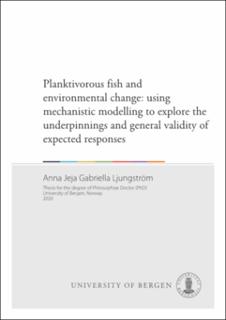Planktivorous fish and environmental change: using mechanistic modelling to explore the underpinnings and general validity of expected responses
Doctoral thesis
Permanent lenke
http://hdl.handle.net/1956/21796Utgivelsesdato
2020-03-13Metadata
Vis full innførselSamlinger
Sammendrag
The living conditions of marine and terrestrial organisms are currently changing at a rapid pace due to human activities. To predict how this will affect them, and hence to develop appropriate management and conservation strategies, we need to identify the fundamental drivers of their ecology and hence the mechanisms that underlie observed spatial and temporal patterns. Present-day climate change is associated with three universal ecological responses: shifts in distribution, shifts in phenology, and declining body size. In this PhD thesis I use mechanistic modelling to investigate the underpinnings and general validity of these three expectations for planktivorous fishes. This work resulted in several unintuitive findings that can improve our understanding and prediction of environmental influences on planktivorous fishes. The first paper shows that seasonality in the resource environments of both parents and their offspring is important for spawning time phenology, but that the relative importance of high offspring fitness (match between birth and conditions that maximize offspring survival) depends on resource dynamics at the feeding grounds of adults. Thus, to better understand and predict changes in phenology and their consequences in marine systems, I advocate for incorporation of both the parental and offspring perspective, for considering changes at different locations, and for modelling optimal annual routines, which describe how annual periodicity affects optimal activity schedules within the annual cycle. Latitudinal variation in body size and recent body size declines in response to climate change are typically linked to gradients and changes in temperature and food abundance.In the second paper, we show that for planktivores that forage through vision, factors that affect the accessibility of prey, particularly the size of prey but also water clarity, are much more important for their optimal body size and energetics. This suggests that inferences based on temperature and prey abundance, or biomass, are likely to have limited predictive ability, and future work should prioritize research to improve predictions of body size shifts in this group. The third paper explores how accounting for increasing light seasonality with latitude affects predictions of poleward shifts and redistributions of visual foragers under global warming. We illustrate that shifts from lower to higher latitudes may be constrained by the long and dark winters at higher latitudes, and by increased predation risk. Contrary to the common expectation, our findings also suggest that ocean warming could lead to shifts towards the equator, and that the optimal direction of shift may vary between the seasons and among individuals of different body sizes. In the paper, we discuss the implications of our findings for predicting warming-driven redistributions in visual foragers.
Består av
Paper I: Ljungström G, Francis TB, Mangel M, Jørgensen C (2019) Parent-offspring conflict over reproductive timing: ecological dynamics far away and at other times may explain spawning variability in Pacific herring. ICES Journal of Marine Science, 76, 559–572. The article is available at: http://hdl.handle.net/1956/21795Paper II: Ljungström G, Claireaux, M, Fiksen Ø, Jørgensen C (2019). Body size and climate change: zooplankton community is more important than temperature or food abundance in planktivore fish model. Marine Ecology Progress Series. The article is available in the main thesis. The article is also available at: https://doi.org/10.3354/meps13241
Paper III: Ljungström G, Langbehn, T, Jørgensen C. Increasing light seasonality with latitude: implications for forecasting of warming-driven redistributions in visual foragers. Full text not available in BORA.
